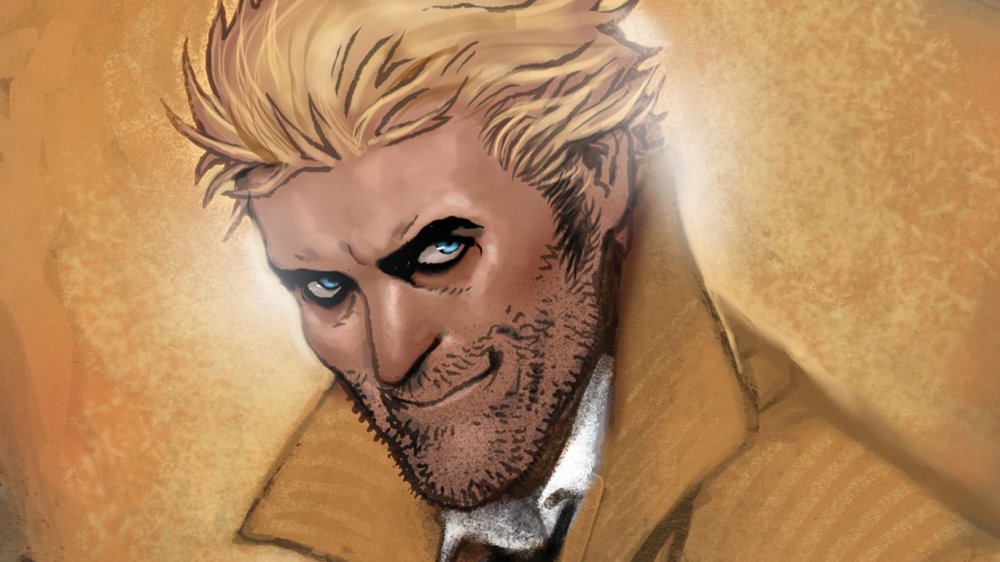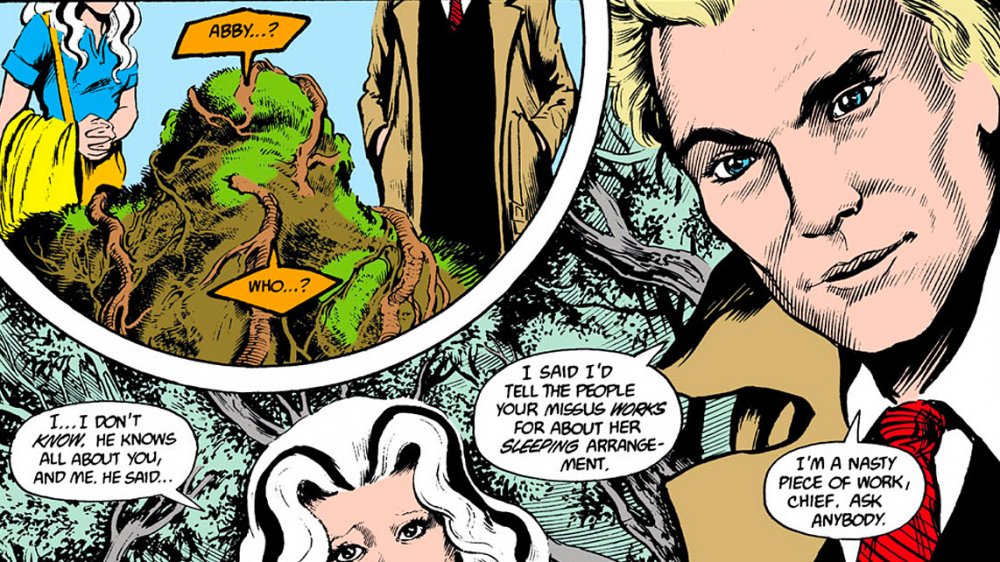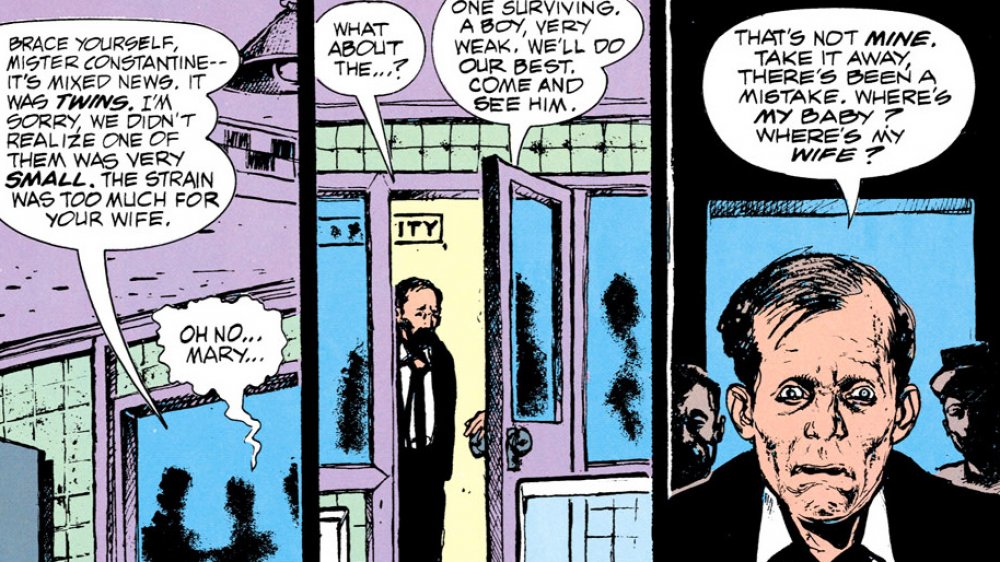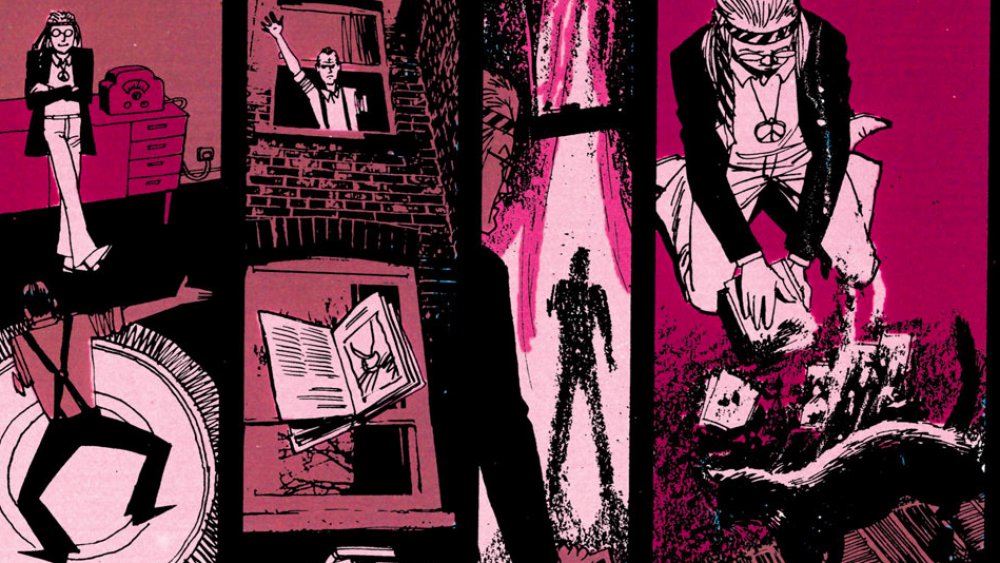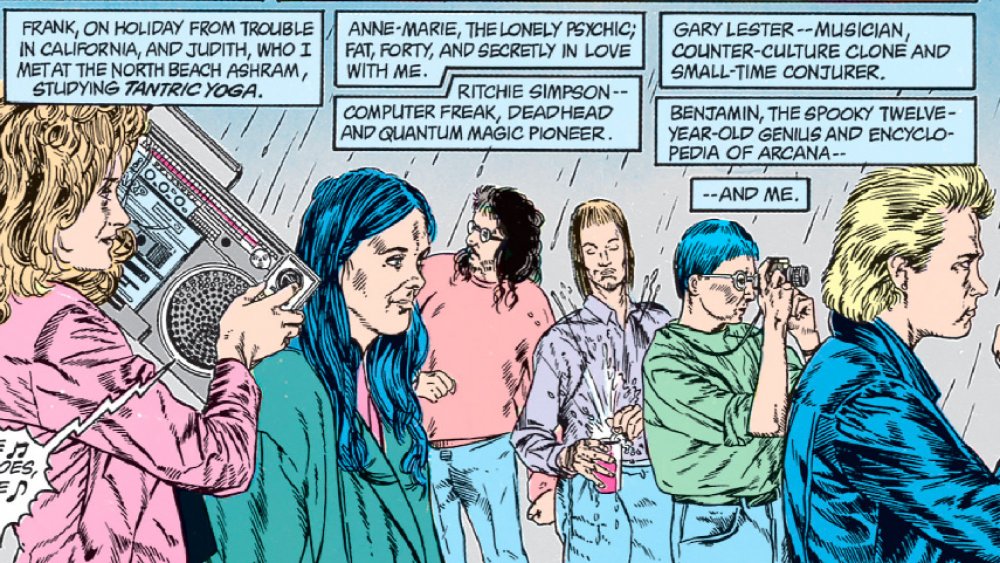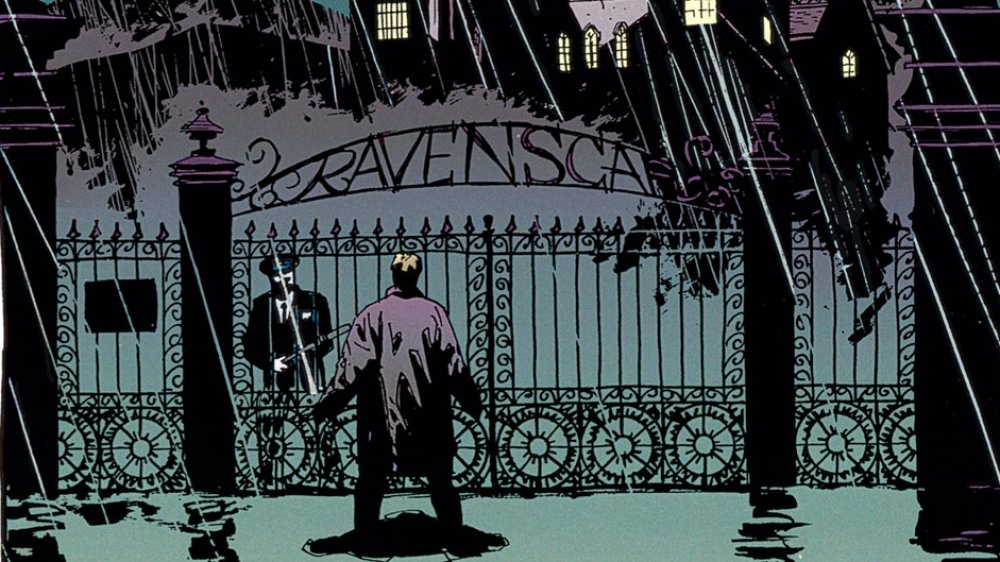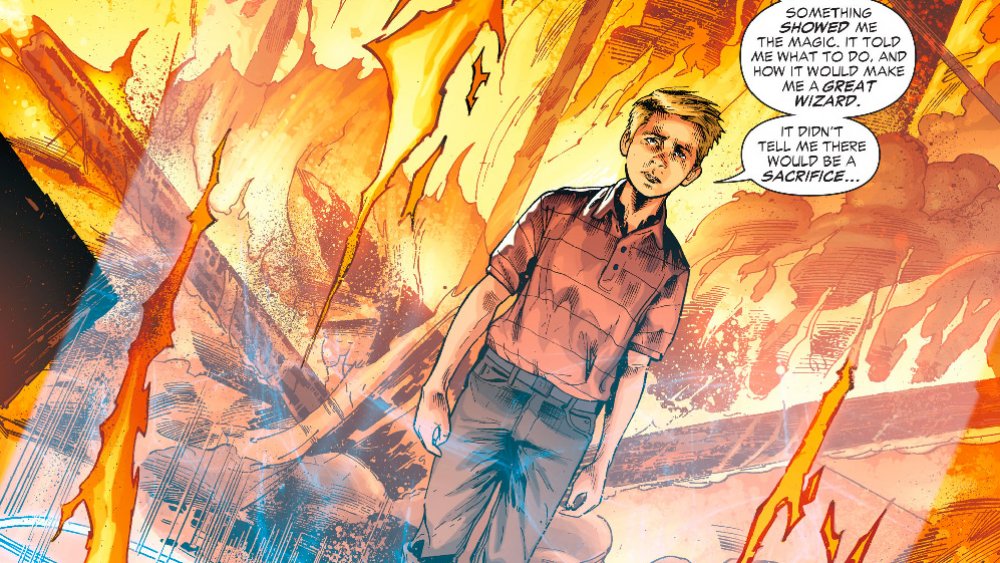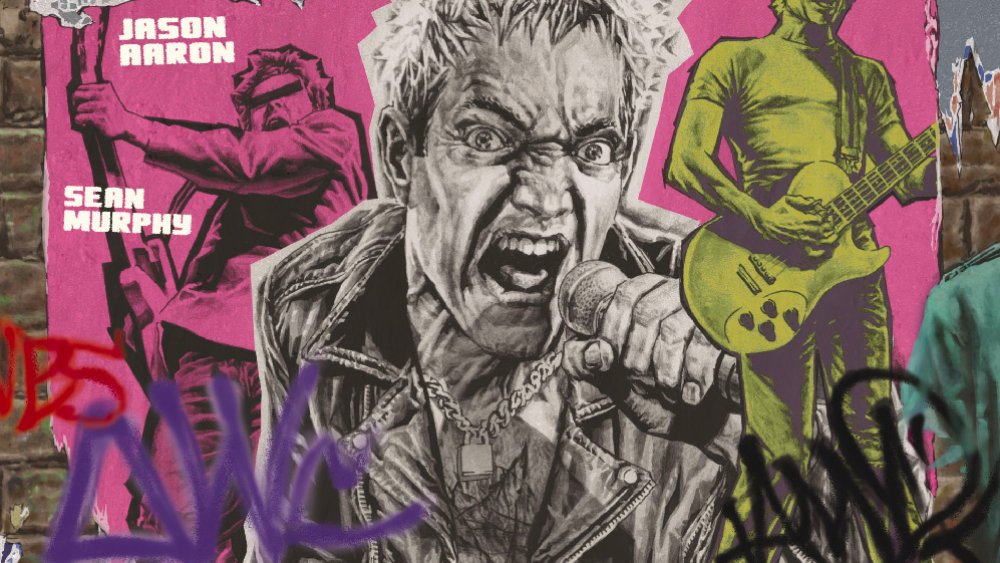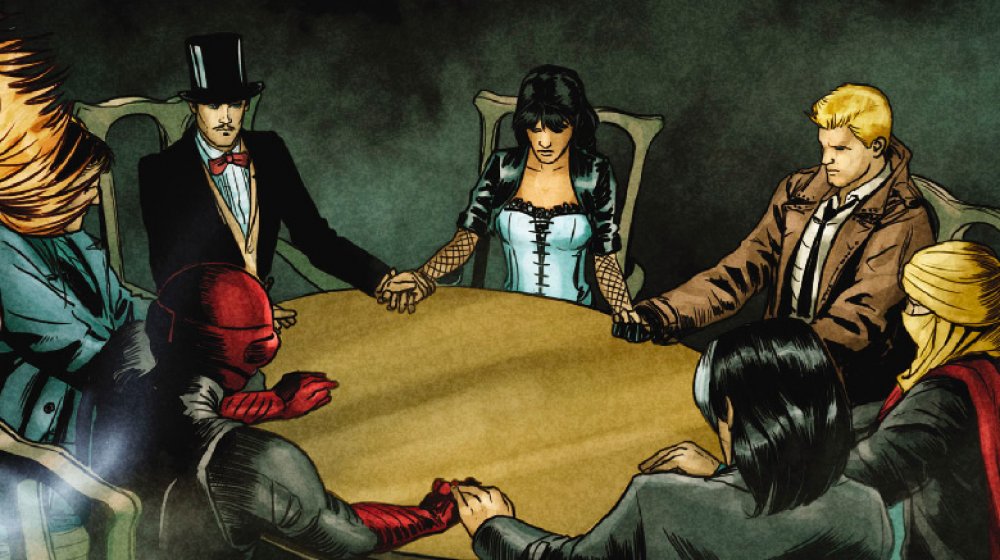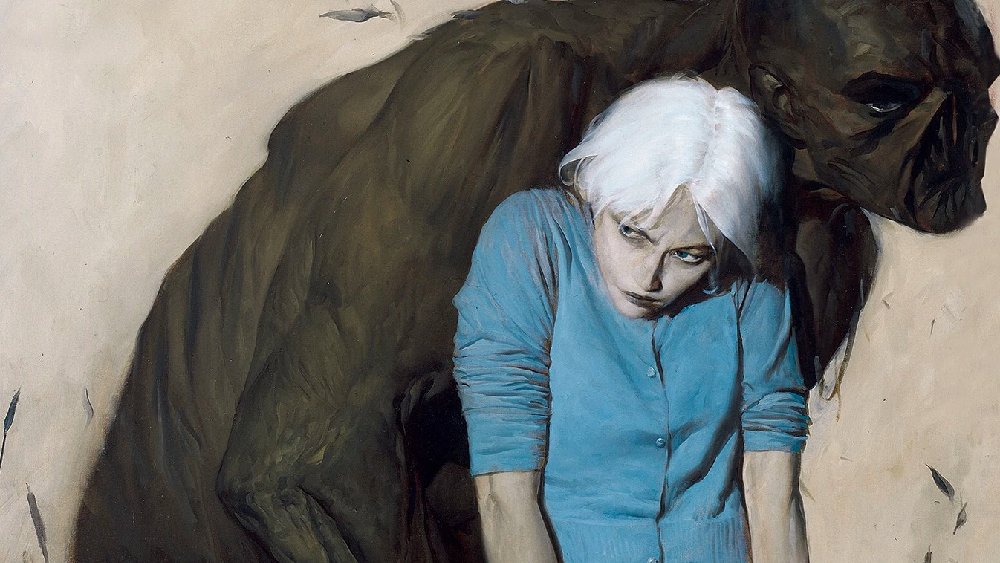John Constantine's Entire Backstory Explained
If you hear someone talking about a sorcerer who uses his magic to battle evil in a superhero universe, you probably think of someone like Doctor Strange — a wizard armed with countless ancient artifacts, someone whose disciplined mind allows them to wield strange, eldritch powers summoned up by complex incantations. You probably don't think of some extremely sketchy dude who looks like he might've heard of showers but has never actually experienced one, hacking up a lung and puffing on his fifth pack of cigarettes, wrapped up in the kind of coat usually favored by cold-weather perverts.
Unless, of course, you're in the DC Universe. If you are, then you know that the jerk who showed up to the Justice League's emergency meeting half-drunk without even fixing his tie is actually John Constantine, and that he might just be the only thing standing between you and complete mystical annihilation. Despite his appearance (as well as his bad attitude and his unfortunate tendency to get his friends murdered), he's the DCU's go-to guy when it comes to magical threats. As for how he got there and just why he puts up such an unpleasant front, well, it's a long and tragic story. Here's the entire backstory for the Hellblazer himself, John Constantine.
The Sting of inspiration
Before we get into the in-universe history of DC's unluckiest mystic, it's worth taking a look at the behind-the-scenes story of how he came to be, because he doesn't really have the real-world origin story that you might expect. After all, while most of the UK's famous fictional spellcasters descend from the tradition of Merlin, our boy John was inspired by a very different British hero: Gordon Sumner, better known as Sting. Yeah, the musician.
Like a lot of great characters, the story behind John Constantine's first appearance in Swamp Thing #37 is actually pretty simple. When writer Alan Moore asked artists Steve Bissette and John Totleben what they wanted to draw — always a good idea when someone has to knock out 22 pages worth of art every month — they told him they wanted to draw Sting or at least someone who looked like him. In fact, they'd already done it before in Swamp Thing #25, and they apparently found the musician to be fun enough to draw that they wanted to give him a featured role. Moore thought Sting's striking look would work for a charismatic, manipulative magician that he had in mind, and thus, John Constantine stepped onto the page, looking like he was about four seconds away from telling Swamp Thing not to stand so close to him.
As for the specific visual references that Bissette and Totleben were drawing from, the long coat and suit look that would become John Constantine's trademark was inspired by Sting's appearance in 1979's Quadrophenia, based on the Who album of the same name. Another inspiration, though, was much more esoteric — a 1982 TV movie called Brimstone & Treacle, where Sting played a disturbing, fourth-wall breaking character who may or may not have been the devil. Pretty fitting, all things considered.
John Constantine's unhappy birthday
Saying that John Constantine has had a rough life is putting things pretty mildly. There are very few characters in comics — and honestly, very few fictional characters period — who've had quite as much misery heaped on them over the years. In John's case, as revealed in Hellblazer #39, it started even before he was born.
As a child, John occasionally had visions of what he called the "Golden Boy," who was essentially just that — an "imaginary friend" made up of shining golden light that John both loved and hated for his seeming perfection. After he grew up, though, John learned that he was neither imaginary nor a friend but a parallel world echo of the twin brother John never even knew he had.
The existence of a twin wasn't just news to him. The doctors who delivered John as a baby were also pretty surprised when it turned out that Mary Anne Constantine had been pregnant with a second child, as one of them was so sickly and underweight that he'd gone unnoticed. The healthier child didn't make it, though. He'd been strangled in the womb, and neither he nor Mary survived the birth. The other baby was, of course, John, whose childhood was marked by intense hatred and resentment from his father, who made it very clear that he wished John had been the one who'd died instead.
Brace yourselves, folks. It's not going to get any happier from here on out.
Constantine's relationship with his dad was pretty twisted
It probably won't surprise you to learn that John and his father, Thomas Constantine, didn't really get along while John was growing up. Not only did Thomas blame John for Mary's death, he was also disappointed in him for other reasons. Thomas wanted a "normal" son who would fit in with the other kids at school, rather than a young weirdo who spent all his time on books about magic and demons.
Thomas burned a stack of his son's books in a fit of anger, hoping to drive him away from sorcery. All things considered, this might've actually worked out for the best, but John was furious, and he decided to get back at his dad through the method available to him — cursing him by binding his soul to a dead cat. In what was likely John's first great success with magic — for certain values of "success" — the spell worked. Before long, Thomas was wasting away from an inexplicable disease as the feline corpse rotted, but John was left feeling guilty about what he'd done to his old man. Since the spell couldn't be reversed, he preserved the cat in formaldehyde, stopping his father from degenerating any further.
Cut to a few decades later, and Thomas finally died, only for his soul to be stuck on Earth, terrifying John's niece, Gemma, until John realized that as long as the preserved cat-daver (ha-ha!) was around, Thomas would be bound by it and continue suffering. To finally free him, John dug up the cat from where he'd buried it — under his mother's tombstone, because things weren't quite dark enough already — and burned it, finally setting his father free.
The tragedy of the Newcastle Crew
If John Constantine has an origin story in the traditional superhero sense, then it's what went down with the Newcastle Crew's disastrous attempt to help a young girl. The gory details are in Hellblazer #11, and they are not for the faint of heart.
It happens early on in John's career as a freelance magician, when he hears about some bad stuff going down at the Casanova, a club in Newcastle where he used to play with his band. The club's owner was involved with the same sort of shady magic scene that John was, but his proclivities were far more disturbing and involved abusing his daughter, Astra Logue. Eventually, Astra manifested a monster called the "Norfulthing," described as being half-dog, half-orangutan, and "all insidey-out." After being summoned, the Norfulthing does to the club owner and his "guests," well, exactly what they did to Astra, plus tearing off their heads and turning the basement of the Casanova into a charnel house. Not entirely undeserved, but also not the sort of thing you want running around unchecked.
To deal with the Norfulthing, John put together a crew of six other occultists (aka the Newcastle Crew), and he came up with the not-so-brilliant plan of summoning a powerful demon to kill Astra's monster. It won't shock you to learn that this didn't go well. While the ritual was correct, Constantine got the wrong name for the demon, and since the name is the thing that provides control, he essentially unleashed a horrifying and hungry force on himself, his friends, and poor Astra. The demon, Nergal, did in fact destroy the Norfulthing, but it then turned on John and his friends. John was forced to lead Astra through Hell itself in an attempt to save her soul, and while he held tight to her hand for the whole trip, said hand didn't stay attached to the rest of the girl. She was dragged to Hell, and the rest of the Newcastle crew was left traumatized, with all of them meeting grisly fates before their souls were condemned to Hell. As for John, he managed to avoid eternal damnation (this time), but he wound up suffering his own personal hell for the next few years.
John Constantine's time at Ravenscar
The contingency plan for summoning the demon at the Casanova was one that we can probably all get behind: blowing it up with a very enthusiastic round of arson. Unfortunately for John, setting things on fire tends to be very effective at both solving problems and creating them. When this weirdo emerged from a fire clutching a severed hand and ranting about a demon that dragged him to Hell, he wound up being taken to the Ravenscar Secure Hospital, a miserable and disreputable asylum for the criminally insane. And by the standards of DC comics, that's saying something.
The chief problem for Constantnie was that while he was certainly traumatized, he wasn't actually hallucinating. There was, in fact, a demon that was after his soul, which had butchered a handful of adults and done something unspeakably horrible to a young girl, but the only thing that the staff and inmates of Ravenscar knew was that all this bad stuff happened and John was involved. As a result, Constantine was beaten by the inmates and tortured by the doctors under the guise of "treatment," with electro-convulsive "therapy" being a favorite tactic. All of this only served to amplify his self-loathing and the guilt he felt for his plan going so horrifically wrong. As Hellblazer #50 put it in one of its typically cheerful moments, "The only reason he hated them was that they wouldn't cut his throat and end the agony."
John's tenure at Ravenscar lasted two years, but the memory of both the events that led him there and the treatment he received in its walls would haunt him for the rest of his life, in both a metaphorical sense and, on occasion, a frighteningly literal one.
Ring of fire
Like a lot of comic book characters, there are different versions of John Constantine's backstory depending on what comics you're reading, but his path is weirder than most. When he was introduced in the pages of Swamp Thing, it was as part of the DC Universe. Most of his own series, however, was published by DC's Vertigo imprint, a line initially focused on horror titles for adult readers that was separated from the bright, superheroic world of the main DC comics. Eventually, after about 20 years of being sequestered in his own supernatural universe, Constantine was folded back into the DCU proper, where his origin was revised, with slightly less of the disturbing darkness involved.
The key word there is "slightly." The origin story that led Constantine to joining up with Justice League Dark and dealing with the DC Universe's magical threats still wound its way through Newcastle, Astra Logue's damnation, and a stint in Ravenscar Asylum. This time, though, things started to go bad much earlier. In Constantine #14, readers learned that at a very young age, Li'l John encountered some sinister demonic force that offered him magical power. John eagerly accepted, but as is usually the case with this sort of thing, he wasn't told about the price of this power until it was too late to do anything about it.
The price, in typically tragic fashion, was John's home and family. In his first use of magic, Constantine burned down his childhood house, standing untouched in the center of the flames while his mother and father were burned to death in front of him. That makes sense, though, even for the brighter version of the DC Universe. After all, they don't really let you in the Justice League if you don't have some kind of parent-based tragedy in your past.
Before he was a magician, he was a musician
One element of Constantine's pre-trenchcoat life that's consistent among various versions of the character is that his career path wasn't always geared towards skulking around in a trenchcoat and manipulating swamp monsters into doing his mysterious and vaguely sinister bidding. Back before that, he was into some really disreputable stuff: rock 'n' roll.
Back in his younger days, Constantine, under the not-so-great stage name "Johnny Con-Job," was the lead singer in a punk band called Mucous Membrane. According to Constantine himself, they weren't very good when it came to the actual music — although "no worse than a lot of others that were around" back when everyone wanted to be the Sex Pistols — but their brief time in the grotesque spotlights of British punk clubs did see them find some success. Of course, that had a lot less to do with their musical talent than it did with the undeniable charisma of their frontman, who would later use those skills to slightly more profitable effect as a sorcerous con artist and part-time Justice Leaguer.
The reason that Mucous Membrane broke up varies from one series to the next. In the current DC Universe, it was prompted by Constantine's use of magic as part of his stagecraft, which caused his bandmate and lover, Veronica Delacroix, to fade away from the physical world until she became a disembodied spirit. In the classic Vertigo comics, it had more to do with the Newcastle incident and John's subsequent commitment to Ravenscar. If you're curious, though, it's probably best not to go looking for answers. An amateur documentary crew trying to find out what happened to Mucous Membrane starred in a story that ran through Hellblazer #245 to 246, where they were all violently murdered by the remnants of Astra's terror elemental, the Norfulthing.
His complicated relationship with Zatanna
The world of wizardry is a small one where everyone pretty much knows everyone else. After all, it's a lot easier to remember someone's name when you run into them unexpectedly at a party if, you know, they're a lumbering swamp monster who embodies the entire planet's vegetable life or if they insist that they're only to be referred to as "The Phantom Stranger."
With that in mind, it's no surprise that another one of the more consistent elements in Constantine's life is his romantic history with stage magician, legitimate sorceress, Justice Leaguer, and hosiery enthusiast Zatanna Zatara. The backwards-talking spellcaster (who definitely needs her own movie) predates John's existence in comics by a good 20 years, but their pasts have been depicted as being intertwined since very early in Constantine's existence. Sadly, the way their lives are tangled together is about as tragic as everything else in Constantine's past. While they do maintain some level of affection for each other, there is a pretty big sticking point in their history that prompted their initial breakup: Constantine killed her dad.
That's a pretty harsh way of putting it, of course. Constantine didn't intentionally end John Zatara's life, but he was the driving force behind a magical ritual that both John Zatara and Zatanna participated in that resulted in her father bursting into flames and dying in front of them. In the original comics, this was an attempt by DC's occult characters to deal with the mystical side of the multiverse-shattering events seen in Crisis on Infinite Earths, but a similar event exists even in the current continuity where Crisis didn't happen. The current version does have a little extra salt and pepper on it, though. Before they broke up, Zatanna cast a spell on John, telling him, "Uoy deen ot eb a retteb nosrep." ("You need to be a better person.") That would explain why Constantine is less of a loner and a bit more eager to help these days, doesn't it?
The weird story behind John Constantine's daughter
John Constantine has never really been a family man — possibly because "The Family Man" is the name of the serial killer who murdered his father, and that's a pretty tough association to overcome when you're thinking about settling down and having kids. Still, there's one piece of his long and sordid history that contradicts his longstanding loner status, and that's the fact that he has a daughter. Sort of. Sometimes. Look, it's complicated.
Constantine was originally introduced as a supporting character for Swamp Thing, and while he's had plenty of success on his own, including starring in Vertigo's longest-running series at 300 issues, he's always had that association. There's another reason that those characters will always be inextricably linked, though. See, believe it or not, the saga of Swamp Thing is, at its heart, a romance between the eponymous muck monster and his wife, Abby Arcane. At one point, after some pretty complicated mystical circumstances that involved the creation of a "seed" that would combine Swampy's plant-based essence with a human soul, Abby and the Swamp Thing decided to have a child of their own. The problem was that Swamp Thing was ... well, a swamp thing, and not a human with ... well, let's just say anatomically correct reproductive organs.
What he did have was a) the ability to take over someone else's body using semi-mystical plant spores and b) someone who owed him several favors. With that in mind, Swamp Thing took over John Constantine's body, flew to Louisiana, and then used him to impregnate Abby with their daughter, Tefe. It is, to put it as mildly as humanly possible, morally dubious, but after Constantine manipulated him into several dubious, semi-sinister errands of his own, Swamp Thing felt justified in his actions as a means to an end. The tree that Swamp Thing got tattooed on Constantine's rear end while he was piloting the guy's body, however, was pure revenge.
